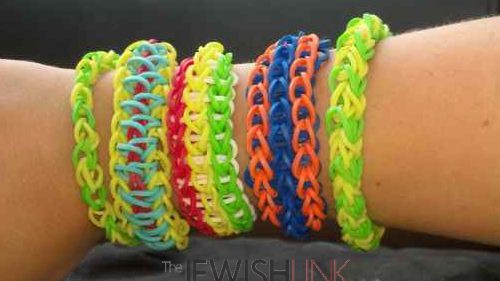Fifth-grade Bais Yaakov girls and gedolei ha’poskim in hilchos Shabbos finally have something in common. Both are very much excited about the popular Rainbow Loom bands—albeit for quite different reasons. For the poskim, finally after all these years, the esoteric melachos of meisach, oseh shtei batei nirin, oreg, and potzei’a have practical everyday application.
But let’s step back a bit to describe the latest craze that has hit not only the Bais Yaakovs but even the boys’ yeshivos. There are miniature weaving looms that colorful rubber bands are fitted onto, and the practitioners of this new pastime are now weaving colorful rubber-band jewelry.
The website states: “Rainbow Loom is a kit for making super fun rubber band links, recommended for 8 years to adult. Younger kids are recommended to use the kit with adult supervision (not for children 3 years or younger). Be sure to check out the instructions page to see a variety of ways to use the kit. Rainbow Loom is so new that new patterns are still being discovered.”
The new craze presents both challenges and opportunity. The challenges can be divided into three categories. We will go through each one.
The First Challenge
One challenge is that entire cadres of young girls and boys are now unwittingly violating four of the most obscure av melachos of Shabbos.
Meisach is setting up the loom. In our case, it is setting up the rubber bands on the plastic mini-loom. Other poskim hold that it is only when the loom is set up on the horizontal side that meisach applies. Regardless, meisach will be violated when the new jewelry is being woven.
Oseh batei nirin in theory is the setting up of the loom itself. The loom used in this modern manifestation works differently. It does not have back-and-forth pedals, but according to some of the explanations found in the Rishonim, the loom used would be a violation of oseh batei nirin too. Some poskim hold that the violation of oseh batei nirin involves merely passing the strings through the weaving machine.
There is also the melachah of oreg, which is the actual weaving. This can be violated even without a loom. The Rainbow Loom offers that possibility too. Indeed, from the fact that there are so many combinations, each different pattern can be a different violation of the above three av melachos.
The fourth category of prohibited melachah involving weaving is called potzei’a. This can involve removing the woven item from the loom, or removing one of the bands from the total bracelet.
Some would like to argue that because the main material being used is made of rubber bands, it is temporary and not a violation of the weaving melachos. However, most Rishonim understand that temporary means less than 24 hours. Experience shows that this is definitely not the case here.
The Second Challenge
There is yet another challenge here, unique to boys. Some of the items being created constitute jewelry, not merely bands. That being the case, the prohibition against wearing articles of clothing unique to women may be violated here. The prohibition is called “simlas isha” and may be tantamount to wearing a dress. We don’t want our yeshiva boys wearing dresses, so why are we letting them wear these decorative bracelets?
The Third Challenge
Finally, the last challenge involves bitul Torah. Many children are bringing these rubber bands and looms to school and working on them during class time. Yeshiva after yeshiva is finding that this has become a widespread problem.
The Opportunity
Notwithstanding all that was said above, the Rainbow Looms also offer tremendous opportunity. For the first time in close to two centuries, we now have an opportunity to teach the four most neglected areas of Hilchos Shabbos, these four av melachos, to an audience that is interested in and familiar with the weaving processes. We should rush to grasp it. v
By Rabbi Yair Hoffman
The author can be reached at yairhoffman2@gmail.com.
